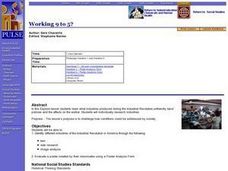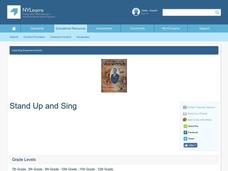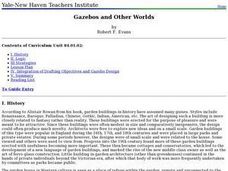Curated OER
A State Divided - Maryland in the Civil War Era
Students use primary sources to see how Maryland was a divided state during the time leading up to the Civil War. In this Civil War lesson plan, students go over vocabulary, and look at maps that show the division of opinions of people...
Curated OER
Working 9 to 5?
Students identify different industries of the Industrial Revolution in America through the following: text, web research and image analysis. They evaluate a poster created by their classmates using a Poster Analysis Form.
National Woman's History Museum
The Triangle Shirtwaist Fire
On March 25, 1911, 146 garment workers died in the Triangle Shirtwaist Factory fire. Class members use primary source documents to research the tragedy and how it lead to the creation of labor unions and new labor laws. As an exit...
American Institute of Physics
Historical Detective: Edward Alexander Bouchet and the Washington-Du Bois Debate over African-American Education
Young scientists meet Edward Alexander Bouchet who, in 1876, was the first African American to receive a PhD in Physics. This two-part lesson first looks at the debate between Booker T. Washington and W.E.B. Du Bois about the type of...
City University of New York
African Americans and the Populist Movement
Why did the Populist Party fail to ally itself with African American farmers? To answer this essential question, class members investigate the Populist Era (188-1900) and read an article written by Tom Watson, a Populist leader.
Curated OER
Child Labor in Maryland: An Historical Investigation
Tenth graders, after reading two excerpts about contemporary child labor situations, discuss two broad questions in detail along with the industrial boom following the Civil War conditions in the United States. They investigate how the...
NET Foundation for Television
1850-1874 Beef Moves to Nebraska
Just how long was the Long Drive? Learners investigate the movement of cattle in the Great Plains during the mid-1800s. They incorporate photographic, newspaper, video, and primary source evidence into their posters, artwork, and written...
National First Ladies' Library
Red Hunts, Black Lists, and Communists
Students research and examine the unsavory history of the hunt for communists in the United States during the 1950s. They divide up into groups to review the Red Scare of the 1920s as a backdrop to the McCarthy era and write a short...
Curated OER
Coal Mine Industrial Picture Analysis
Students observe coal mine pictures. In this US history lesson, students analyze the pictures realizing that history is shown in pictures and then write a newspaper article about life in a coal town using the pictures as sources of...
Curated OER
Geology of Connecticut
Students examine the geology of Connecticut, including plate tectonics, glaciation, and fossil formation.
After reviewing past lessons, they write essays about what life may have been like in the Mesozoic Period. Following a field...
Curated OER
Little House in the Census: Almanzo and Laura Ingalls Wilder
How would you use census data from 1880-1900? Here are a set of ways you can incorporate the book Little House on the Prairie and US census data from that time period. Learners will research the validity or the book based on factual...
Smithsonian Institution
Changing Gender Roles on the Home Front
Many historians discuss how gender roles changed because of World War II, but how did this come to be? An informative resource challenges scholars to do some digging and research the information for themselves. They research how...
Curated OER
Stand Up and Sing
Learners journal and respond to the question," How does society respond to change?" They create original lyrics to their own song that reflects the context of the Progressive Era.
Curated OER
Chapter 3 – Antebellum Innovation, Politics, and the Jackson Administration
The inter-war Antebellum Era was a fascinating time in U.S. History! In this textbook response worksheet, historians read assigned textbook pages regarding the topics and respond to 46 short answer display questions regarding the...
Curated OER
Gazebos and Other Worlds
Design a simple structure such as the gazebo. Work with your class to identify the six faces of a cube pattern and name other uses of patterns in industry. They draft, cut out, and assemble a cube pattern. They draw out and assemble two...
Curated OER
Growing a Nation
Eleventh graders examine the major events and inventions that changed American families and communities. For this US History lesson, 11th graders analyze various documents dealing with the changes. Students create a project on an event...
Curated OER
Frederic Remington: His Life and Time
Eleventh graders discuss the life of frederic remington and visit his museum. In groups, they research topics involving remington and write reports. They assemble their findings into a Web page about remington.
Curated OER
Diseases Are Real
Eleventh graders research industries that contribute to sanitation and pollution problems. They investigate the direct result of unhygienic practices including disease outbreaks or specific illnesses. They create a Power Point...
Curated OER
Social Studies: Westville Through the Years
Students research the history of Westville, Connecticut by investigating three main areas of study. They begin with the town's early history, examine its industrial era, and conclude with its influence in the arts. The instructional...
City University of New York
Urban Politics: Machines and Reformers
What were political machines and whom did they serve? As part of a study of US immigration patterns and how these patterns influenced politics, groups investigate how Tammany Hall and other political machines gained support from voters.
Jersey Heritage
A Victorian Christmas
In many ways, Victorian Christmas is alive and well today! Class members read an informative passage to learn more about traditional Christmas gifts, decorations, crackers, and visits from Santa Claus in nineteenth-century England—as...
Alabama Department of Archives and History
Alabama Tenant Farmers and Sharecroppers, 1865 to Present
The tenant farming and sharecropping systems that developed in the South after the Civil War, the reasons for their development, and the eventual decline of these systems are the focus of this two-day plan.
Annenberg Foundation
America's History in the Making: Classroom Applications Three
How can primary sources bring history to life? Scholars create detailed lesson plans on the late nineteenth and early twentieth centuries in American history. The 17th installment of a 22-part program exploring American history examines...
Alabama Department of Archives and History
Nellie Bly to Dr. Peter Bryce: 19th Century Asylum Reform
What kind of treatment could a patient expect in an asylum during the 1800's? The abusive and neglectful conditions in 19th century asylums are the focus of a lesson plan that examines the work of reformers Nellie Bly, Dorothea Dix, and...

























